Tranmere Rovers
Originally this Birkenhead club was formed as Belmont FC following the amalgamation of Lyndhurst Wanderers FC and Belmont Cricket Club, adopting the blue and white colours of Lyndhurst. Within a year they changed their name to Tranmere Rovers FC.
In 1887 the club moved into a ground at Ravenshaws Field, which was later renamed Prenton Park. In 1889 Rovers adopted a spectacular orange and maroon shirts but these were abandoned in 1904 in favour of the earlier blue and white kit. In 1912 they moved to a new ground at the junction of Temple Road, Prenton Road West and Woodcurch Lane and retained the name Prenton Park: this remains their home to the present. After competing in the Liverpool & District League and then the Lancashire Combination, Rovers stepped up to the Central League in 1919. Their timing proved providential because the following season, four central league clubs were invited to join the new Division Three (North), Rovers among them.
In 1924 a young Dixie Dean, one day short of his 17th birthday, debuted for the club, scoring 27 goals in 30 games before being transferred across the Mersey to Everton, where he set a goal-scoring record likely to stand for all time. Rovers remained no more than an average side but did spend one season (1938-39) in Division Two. During the 1950s the club was in the doldrums although by finishing in 11th place in 1958, they did achieve a place in Division Three when the regional divisions were scrapped. A mere three years later they were relegated to Division Four.
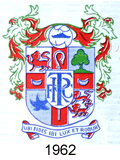 Shortly afterwards the traditional blue shirts were abandoned in favour of an all-white kit that set Rovers apart from their illustrious Mersey neighbours, Everton, adorned for at least one season with the Birkenhead coat of arms. With a vigorous youth policy in place,
Shortly afterwards the traditional blue shirts were abandoned in favour of an all-white kit that set Rovers apart from their illustrious Mersey neighbours, Everton, adorned for at least one season with the Birkenhead coat of arms. With a vigorous youth policy in place,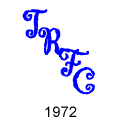 Rovers achieved promotion in 1967.
Rovers achieved promotion in 1967.
In 1972 Rovers adopted a monogramme, a popular motif at the time and this appeared for the next 11 years.
After struggling for eight seasons, Rovers were relegated back to the Fourth Division in 1975 but sprang straight back in 1976. Three years later Tranmere were again relegated to Division Four and faced oblivion due to mounting debts. The club was saved by the generosity of fans and a £200,000 loan from Wirral Metropolitan Council. The partnership proved an enduring one and 30 years later, Wirral MBC's logo still appeared on players' shirts.
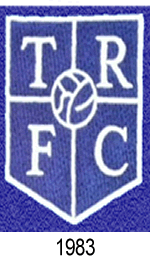 In 1980 Rovers reverted to their traditional blue shirts but performances were bleak and in 1981 they were forced to apply for re-election. A rather unimaginative crest was worn between 1983 and 1985 but as financial problems loomed, the team turned out in unadorned generic strips from the Umbro catalogue.
In 1980 Rovers reverted to their traditional blue shirts but performances were bleak and in 1981 they were forced to apply for re-election. A rather unimaginative crest was worn between 1983 and 1985 but as financial problems loomed, the team turned out in unadorned generic strips from the Umbro catalogue.
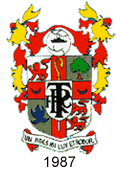 In 1987 another financial crisis loomed and the club went into administration but was saved from catastrophe when local entrepreneur Peter Johnson bought the club. The all-white strip was restored and a complicated new crest was introduced. This featured the motto of the old Birkenhead borough, Ubi Fides ibi Lux et Robur("Where there is faith there is light and strength") a ship on a ball (to represent the Cammell Laird shipyard), a tree (representing Birkenhead Park) as well as a confusing host of other motifs.
In 1987 another financial crisis loomed and the club went into administration but was saved from catastrophe when local entrepreneur Peter Johnson bought the club. The all-white strip was restored and a complicated new crest was introduced. This featured the motto of the old Birkenhead borough, Ubi Fides ibi Lux et Robur("Where there is faith there is light and strength") a ship on a ball (to represent the Cammell Laird shipyard), a tree (representing Birkenhead Park) as well as a confusing host of other motifs.
Rovers won promotion to Division Three in 1989 and then, in 1991 they beat Bolton Wanderers in the play-off final to secure promotion to Division Two. That summer ex-Liverpool goal scoring hero John Aldridge was signed from Real Sociedad for £250,000. Over the next eight years Aldridge scored 170 goals for the club who reached the play-offs three seasons in succession (1993-1995).
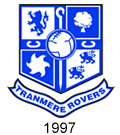 In March 1995 a reconstructed Prenton Park was opened, underlining the board's confidence in the long term future of the Wirral club. The new look was completed with the introduction of a new and simpler crest in 1997.
In March 1995 a reconstructed Prenton Park was opened, underlining the board's confidence in the long term future of the Wirral club. The new look was completed with the introduction of a new and simpler crest in 1997.
Aldridge took on the role of manager in 1999 and led the team to the Worthington (League) Cup final in 2000 where they lost 1-2 to Leicester City. Aldridge resigned after Rovers were relegated to Nationwide Division Two (previously Division Three) in 2001.
Tranmere Rovers have always existed in the shadow of their mighty neighbours Liverpool and Everton. The success of the 1990s during which the club repeatedly came within a whisker of achieving 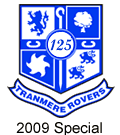 Premier League status is a testament to the club's supporters and board.
Premier League status is a testament to the club's supporters and board.
Although league success has eluded Rovers, they earned a considerable reputation as cup fighters in the new millennium, reaching the FA Cup quarter finals three times between 2001 and 2004 as well as the League Cup final in 2000.
To mark their 125th anniversary in 2009-10, a subtle alteration was made to the crest (for that season only).
